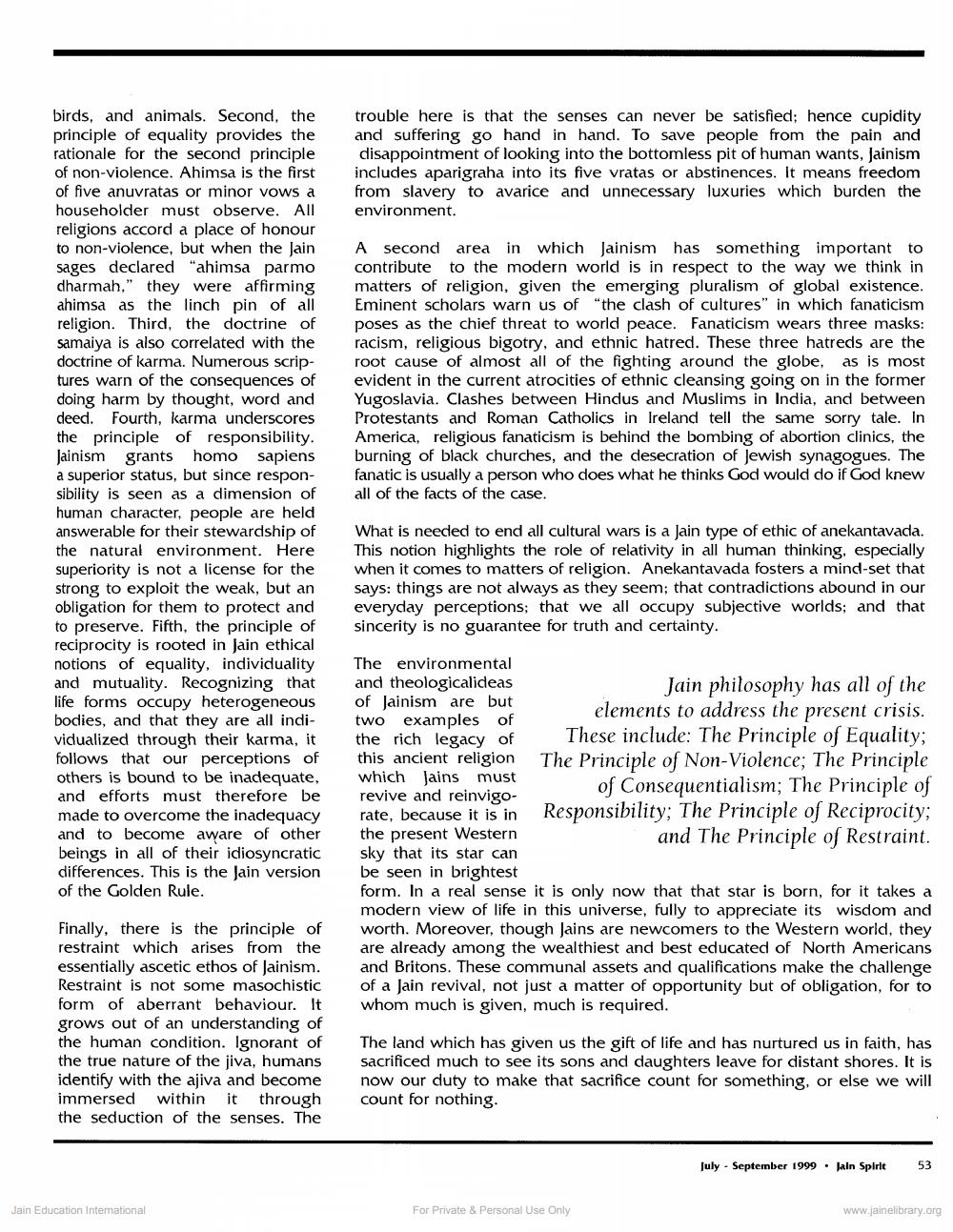________________
birds, and animals. Second, the principle of equality provides the rationale for the second principle of non-violence. Ahimsa is the first of five anuvratas or minor vows a householder must observe. All religions accord a place of honour to non-violence, but when the Jain sages declared "ahimsa parmo dharmah," they were affirming ahimsa as the linch pin of all religion. Third, the doctrine of samaiya is also correlated with the doctrine of karma. Numerous scriptures warn of the consequences of doing harm by thought, word and deed. Fourth, karma underscores the principle of responsibility. Jainism grants homo sapiens a superior status, but since responsibility is seen as a dimension of human character, people are held answerable for their stewardship of the natural environment. Here superiority is not a license for the strong to exploit the weak, but an obligation for them to protect and to preserve. Fifth, the principle of reciprocity is rooted in Jain ethical notions of equality, individuality and mutuality. Recognizing that life forms occupy heterogeneous bodies, and that they are all individualized through their karma, it follows that our perceptions of others is bound to be inadequate, and efforts must therefore be made to overcome the inadequacy and to become aware of other beings in all of their idiosyncratic differences. This is the Jain version of the Golden Rule.
Finally, there is the principle of restraint which arises from the essentially ascetic ethos of Jainism. Restraint is not some masochistic form of aberrant behaviour. It grows out of an understanding of the human condition. Ignorant of the true nature of the jiva, humans identify with the ajiva and become immersed within it through the seduction of the senses. The
Jain Education International
trouble here is that the senses can never be satisfied; hence cupidity and suffering go hand in hand. To save people from the pain and disappointment of looking into the bottomless pit of human wants, Jainism includes aparigraha into its five vratas or abstinences. It means freedom from slavery to avarice and unnecessary luxuries which burden the environment.
A second area in which Jainism has something important to contribute to the modern world is in respect to the way we think in matters of religion, given the emerging pluralism of global existence. Eminent scholars warn us of "the clash of cultures" in which fanaticism poses as the chief threat to world peace. Fanaticism wears three masks: racism, religious bigotry, and ethnic hatred. These three hatreds are the root cause of almost all of the fighting around the globe, as is most evident in the current atrocities of ethnic cleansing going on in the former Yugoslavia. Clashes between Hindus and Muslims in India, and between Protestants and Roman Catholics in Ireland tell the same sorry tale. In America, religious fanaticism is behind the bombing of abortion clinics, the burning of black churches, and the desecration of Jewish synagogues. The fanatic is usually a person who does what he thinks God would do if God knew all of the facts of the case.
What is needed to end all cultural wars is a Jain type of ethic of anekantavada. This notion highlights the role of relativity in all human thinking, especially when it comes to matters of religion. Anekantavada fosters a mind-set that says: things are not always as they seem; that contradictions abound in our everyday perceptions; that we all occupy subjective worlds; and that sincerity is no guarantee for truth and certainty.
The environmental and theologicalideas of Jainism are but two examples of the rich legacy of
this ancient religion
which Jains must revive and reinvigo
rate, because it is in
the present Western sky that its star can be seen in brightest
form. In a real sense it is only now that that star is born, for it takes a modern view of life in this universe, fully to appreciate its wisdom and worth. Moreover, though Jains are newcomers to the Western world, they are already among the wealthiest and best educated of North Americans and Britons. These communal assets and qualifications make the challenge of a Jain revival, not just a matter of opportunity but of obligation, for to whom much is given, much is required.
Jain philosophy has all of the elements to address the present crisis. These include: The Principle of Equality; The Principle of Non-Violence; The Principle of Consequentialism; The Principle of Responsibility; The Principle of Reciprocity; and The Principle of Restraint.
The land which has given us the gift of life and has nurtured us in faith, has sacrificed much to see its sons and daughters leave for distant shores. It is now our duty to make that sacrifice count for something, or else we will count for nothing.
For Private & Personal Use Only
July-September 1999 Jain Spirit
53
www.jainelibrary.org




